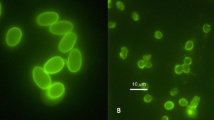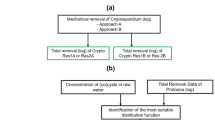Abstract
Gastrointestinal diseases caused by protozoan parasites remain a major challenge in developing countries and ingestion of contaminated surface water represents one of the main sources by which these diseases are contracted. This study assessed the risk of infection and diseases caused by Cryptosporidium spp. and Giardia sp. due to ingestion of surface water used for public supply and recreational activities, focusing on the southeastern Brazilian Pardo River and applying the USEPA 1623 method to quantify (oo)cyst concentrations. Infection and disease probabilities due to ingestion of drinking water or during recreational activities were estimated using the Quantitative Microbial Risk Assessment (QMRA) approach. Mean concentrations of Cryptosporidium spp. and Giardia sp. in surface water ranged from 0.2 to 0.4 oocysts L−1 and 0.2 to 4.4 cysts L−1, respectively. Considering public water supply, annual infection probabilities were higher for adults than children and exceeded the USEPA limit; also, disease probabilities were higher for adults than children. For recreational activities, annual infection and disease probabilities were higher for children, followed by men and women. The occurrence of both parasites likely reflects raw sewage discharge, effluent from sewage treatment plants, and diffuse sources of pollution, such as runoff from pasture lands and deforested riparian forest corridors. Our results highlight substantial infection risks by both parasite types after conventional treatment of water used for public supply and also call for careful monitoring of water bodies used for recreational purposes.


Similar content being viewed by others
Data availability
All data generated or analyzed during this study will be made available to interested researchers upon reasonable request.
References
Alves, R. I. S., Machado, G. P., Zagui, G. S., Bandeira, O. A., Santos, D. V., Nadal, M., Sierra, J., Domingo, J. L., & Segura-Muñoz, S. I. (2019). Metals risk assessment for children’s health in water and particulate matter in a southeastern Brazilian city. Environmental Research, 177, 108623. https://doi.org/10.1016/j.envres.2019.108623
Ana. (2020). Agência Nacional de Água e Saneamento Básico. Conjuntura dos Recusos Hídricos no Brasil. 2020. Brasília: ANA
Bataiero, M. O., Araujo, R. S., Nardocci, A. C., Matté, M. H., Sato, M. I. Z., Lauretto, M. S., & Razzolini, M. T. P. (2019). Quantification of Giardia and Cryptosporidium in surface water: A risk assessment and molecular characterization. Water Science and Technology: Water Supply, 19, 1823–1830. https://doi.org/10.2166/ws.2019.059
Betancourt, W. Q., Duarte, D. C., Vásquez, R. C., & Gurian, P. L. (2014). Cryptosporidium and Giardia in tropical recreational marine waters contaminated with domestic sewage: Estimation of bathing-associated disease risks. Marine Pollution Bulletin, 85, 268–273. https://doi.org/10.1016/j.marpolbul.2014.05.059
Ćirković, V., Klun, I., Utaaker, K. S., Uzelac, A., Tysnes, K. R., Robertson, L. J., & Djurković-Djaković, O. (2020). Surface waters as a potential source of Giardia and Cryptosporidium in Serbia. Experimental Parasitology, 209, 107824. https://doi.org/10.1016/j.exppara.2019.107824
CDC. (2021). Center for Disease Control and Prevention. Available at: https://www.cdc.gov/. Accessed 30 Mar 2021.
Companhia Ambiental do Estado de São Paulo (CETESB). (2020). Qualidade das águas interiores no estado de São Paulo 2020. CETESB, São Paulo: CETESB
CVE. (2021). Centro de Vigilância Epidemiológica. Surtos DTA. http://www.saude.sp.gov.br/cve-centro-de-vigilancia-epidemiologica-prof.-alexandre-vranjac/areas-de-vigilancia/doencas-de-transmissao-hidrica-e-alimentar/dados-estatisticos/surtos-de-dtas/surtos-dta. Accessed 10 Aug 2021.
Delahoy, M. J., Wodnik, B., McAliley, L., Penakalapati, G., Swarthout, J., Freeman, M. C., & Levy, K. (2018). Pathogens transmitted in animal feces in low- and middle-income countries. International Journal of Hygiene and Environmental Health, 221, 661–676. https://doi.org/10.1016/j.ijheh.2018.03.005
Dupont, H. L., Chappel, C. L., Okhuysen, P. C., Rose, J. B., & Jakubonski, W. (1995). The infectivity of Cryptosporidium parvum in healthy volunteers. New England Journal of Medicine, 332, 855–859. https://doi.org/10.1056/NEJM199503303321304
Embrapa. (2021). Empresa Brasileira de Pesquisa Agropecuária Ministério da Agricultura, Pecuária e Abastecimento. Available at: https://www.embrapa.br/grandes-contribuicoes-para-a-agricultura-brasileira/pecuaria. Accessed 20 May 2021.
European Union (EU). (2002). Commission of the European Communities. Proposal for a Directive of the European Parliament and of the council concerning the quality of bathing water.
Fregonesi, B. M., Suzuki, M. N., Machado, C. S., Tonani, K. A. A., Fernandes, A. P. M., Monroe, A. A., Cervi, M. C., & Segura-Muñoz, S. (2015). Emergent and re-emergent parasites in HIV-infected children: Immunological and socio-environmental conditions that are involved in the transmission of Giardia spp. and Cryptosporidium spp. Revista Da Sociedade Brasileira De Medicina Tropical, 48, 753–758. https://doi.org/10.1590/0037-8682-0119-2015
Hadi, M., Mesdaghinia, A., Yunesian, M., Nasseri, S., Nabuzadeh-Nodehi, R., Tashauoei, H., Jalilzadeh, E., & Zarinnejad, R. (2016). Contribution of environmental media to cryptosporidiosis and giardiasis prevalence in Tehran: A focus on surface waters. Environmental Science and Pollution Research International, 23, 19317–19329. https://doi.org/10.1007/s11356-016-7055-9
Hass, C. N., Rose, J. B., & Gerba, C. P. (2014). Quantitative microbial risk assessment. John Wiley e Sons.
Imre, K., Morar, A., Ilie, M. S., Plutzer, J., Imre, M., Emil, T., Herbei, M. V., & Dărăbuș, G. (2017). Survey of the occurrence and human infective potential of Giardia duodenalis and Cryptosporidium spp. in wastewater and different surface water sources of Western Romania. Vector-Borne and Zoonotic Diseases, 17, 685–691. https://doi.org/10.1089/vbz.2017.2155
Innes, E. A., Chalmers, R. M., Wells, B., & Pawlowic, M. C. (2020). A One Health approach to tackle cryptosporidiosis. Trends in Parasitology, 36, 290–303. https://doi.org/10.1016/j.pt.2019.12.016
Krecek, R. C., Rabinowitz, P. M., & Conrad, P. A. (2020). Demystifying and demonstrating the value of a One Health approach to parasitological challenges. Veterinary Parasitology, 287, 109202. https://doi.org/10.1016/j.vetpar.2020.109202
Kahn, H., & Stralka, K. (2009). Estimated daily average per capita water ingestion by child and adult age categories based on USDA’s 1994–1996 and 1998 continuing survey of food intakes by individuals. Journal of Exposure Science and Environmental Epidemiology, 19, 396–404. https://doi.org/10.1038/jes.2008.29
Lee, S. C., Ngui, R., Tan, T. K., Roslan, M. A., Ithoi, I., Mahdy, M. A. K., et al. (2017). Understanding Giardia infections among rural communities using the one health approach. Acta Tropica, 176, 349–354. https://doi.org/10.1016/j.actatropica.2017.08.030
Machado, C. S., Alves, R. I. S., Fregonesi, B. M., Beda, C. F., Suzuki, M. N., Trevilato, R. B., et al. (2015). Integrating three tools for the environmental assessment of the Pardo River Brazil. Environmental Monitoring and Assessment, 187, 569. https://doi.org/10.1007/s10661-015-4788-8
Machado, C. S., Fregonesi, B. M., Alves, R. I. S., Tonani, K. A. A., Sierra, J., Martinis, B. S., Celere, B. S., Mari, M., Schuhmacher, M., Nadal, M., et al. (2017). Health risks of environmental exposure to metals and herbicides in the Pardo River, Brazil. Environmental Science and Pollution Research International, 24, 20160–20172. https://doi.org/10.1007/s11356-017-9461-z
Nieminski, E. C. (1997). Removal of Cryptosporidium and Giardia trough conventional water treatment and direct filtration. EPA/600/SR-97/025. Available at: https://nepis.epa.gov/Exe/ZyNET.exe/30003XAY.txt?ZyActionD=ZyDocument&Client=EPA&Index=1995%20Thru%201999&Docs=&Query=&Time=&EndTime=&SearchMethod=1&TocRestrict=n&Toc=&TocEntry=&QField=&QFieldYear=&QFieldMonth=&QFieldDay=&UseQField=&IntQFieldOp=0&ExtQFieldOp=0&XmlQuery=&File=D%3A%5CZYFILES%5CINDEX%20DATA%5C95THRU99%5CTXT%5C00000009%5C30003XAY.txt&User=ANONYMOUS&Password=anonymous&SortMethod=h%7C-&MaximumDocuments=1&FuzzyDegree=0&ImageQuality=r75g8/r75g8/x150y150g16/i425&Display=hpfr&DefSeekPage=x&SearchBack=ZyActionL&Back=ZyActionS&BackDesc=Results%20page&MaximumPages=1&ZyEntry=1
Razzolini, M. T. P., Breternitz, B. S., Kuchkarin, B., & Bastos, V. K. (2020). Cryptosporidium and Giardia in urban wastewater: A challenge to overcome. Environmental Pollution, 257, 113545. https://doi.org/10.1016/j.envpol.2019.113545
Razzolini, M. T. P., Laureto, M. S., Hachich, E. M., Sato, M. I. Z., & Nardocci, A. C. (2016). Giardia and Cryptosporidium infection risk by simultaneous exposure to drinking water. Microbial Risk Analysis, 4, 1–6. https://doi.org/10.1016/j.mran.2016.01.001
Rosado-García, F. M., Guerrero-Flórez, M., Karanis, G., Hinojosa, M. D., & Karanis, P. (2017). Water-borne protozoa parasites: The Latin American pespective. International Journal of Hygiene and Environmental Health, 220, 783–798. https://doi.org/10.1016/j.ijheh.2017.03.008
Rose, J. B., Haas, C. N., & Regli, S. (1991). Risk assessment and control of waterborne giardiasis. American Journal of Public Health, 81, 709–713. https://doi.org/10.2105/ajph.81.6.709
Sato, M. I. Z., Galvani, A. T., Padula, J. A., Nardocci, A. C., Lauretto, M. S., Razzolini, M. T. P., & Hachich, E. M. (2013). Assessing the infection risk of Giardia and Cryptosporidium in public drinking water delivered by surface water systems in São Paulo State, Brazil. Science of the Total Environment, 442, 389–396. https://doi.org/10.1016/j.scitotenv.2012.09.077
Schets, F. M., Schijven, J. F., & Husman, A. M. R. (2011). Exposure assessment for swimmers in bathing waters and swimming pools. Water Research, 45, 2392–2400. https://doi.org/10.1016/j.watres.2011.01.025
SNIRH. (2021). Sistema Nacional de Informações sobre Recursos Hídricos. Available at: https://portal1.snirh.gov.br/ana/apps/webappviewer/index.html?id=0d9d29ec24cc49df89965f05fc5b96b9. Accessed 30 Mar 2021.
Siwila, J., Mwaba, F., Chidumayo, N., & Mubanga, C. (2020). Food and waterborne protozoan parasites: The African perspective. Food and Waterborne Parasitology, 20, e00088. https://doi.org/10.1016/j.fawpar.2020.e00088
Toledo, R. D., Martins, F. D., Ferreira, F. P., Almeida, J. C., Ogawa, L., Santos, H. L., Santos, M. M., Pinheiro, F. A., Navarro, I., Garcia, J. L., et al. (2017). Cryptosporidium spp. and Giardia spp. in feces and water and the associated exposure factors on dairy farms. PLoS ONE, 12, 1–20. https://doi.org/10.1371/journal.pone.0175311
Tonani, K. A. A., Padula, J. A., Julião, F. C., Fregonesi, B. M., Alves, R. I. S., Sampaio, C. F., Beda, C. F., Hachich, E. M., & Segura-Muñoz, S. I. (2013). Persistence of Giardia, Cryptosporidium, Rotavirus and Adenovirus in treated sewage in São Paulo state, Brazil. Journal of Parasitology, 99, 1144–1147. https://doi.org/10.1645/12-121.1
United States Environmental Protection Agency (USEPA). (2002). National primary drinking water regulations: Long Term 1 Enhanced Surface Water Treatment Rule. Final Rule. Federal Register, 14, 1811–1844.
United States Environmental Protection Agency (USEPA). (2012). Microbial risk assessment guideline: pathogenic organisms with focus on food and water. FSIS Publication n° USDA/FSIS/2012–001; EPA Publication n° EPA/100/J12/001. Available at: https://www.epa.gov/sites/default/files/2013-09/documents/mra-guideline-final.pdf
United States Environmental Protection Agency (USEPA). (2005). Method 1623: Cryptosporidium and Giardia in water by filtration/IMS/FA. EPA-821-R-01–025. Office of Water. Washington DC. Available at: https://www.epa.gov/sites/default/files/2015-07/documents/epa-1623.pdf
Ware, M. W., Wymer, L., Lindquist, A., & Schaefer, F. W. (2003). Evaluation of an alternative IMS dissociation procedure for use with Method 1622: Detection of Cryptosporidium in water. Journal of Microbiological Methods, 55, 575–583. https://doi.org/10.1016/j.mimet.2003.06.001
Zagui, G. S., Andrade, L. N., Moreira, N. C., Silva, T. V., Machado, G. P., Darini, A. L. C., & Segura-Muñoz, S. I. (2020). Gram-negative bacteria carrying β-lactamase encoding genes in hospital and urban wastewater in Brazil. Environmental Monitoring and Assessment, 192, 376. https://doi.org/10.1007/s10661-020-08319-w
Acknowledgements
The present study is the result of research activities related to the monitoring and assessment of water quality that were supported by the São Paulo Research Foundation (FAPESP), the Coordination for the Improvement of Higher Education Personnel (CAPES), and the National Council for Scientific and Technological Development (CNPq).
Funding
This work received financial support from the São Paulo Research Foundation (FAPESP; grant number 2013/07238–2) and the State Water Resources Fund (FEHIDRO; grant number 105/2013).
Author information
Authors and Affiliations
Corresponding author
Ethics declarations
Conflict of interest
The authors declare no competing interests.
Additional information
Publisher's Note
Springer Nature remains neutral with regard to jurisdictional claims in published maps and institutional affiliations.
Rights and permissions
About this article
Cite this article
Fregonesi, B.M., Zagui, G.S., de Abreu Tonani, K.A. et al. Human health risk assessment for (re)emerging protozoan parasites in surface water used for public supply and recreational activities. Environ Monit Assess 194, 407 (2022). https://doi.org/10.1007/s10661-022-10058-z
Received:
Accepted:
Published:
DOI: https://doi.org/10.1007/s10661-022-10058-z




